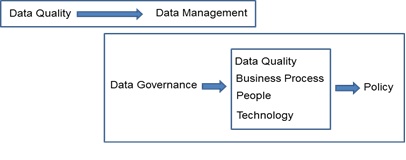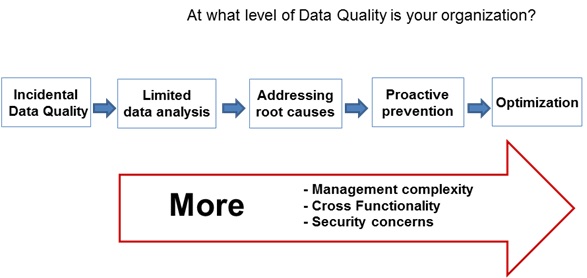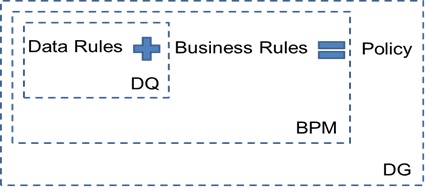
Planning and executing a strategy around the quality and assurance of information requires a lot of effort. An analyst from TEC discusses everything you need to know to get started
In our modern corporate reality, information drives business. Information is the essential element for making decisions at all levels (executive, strategic, and operational). When a company executes projects devoted to maintaining its security, ensuring its reliability, and keeping it up to date, we consider the company to have a data management strategy.
One of the essential features of data management is the deployment of data quality processes to ensure data has the necessary integrity to be used with confidence by an organization. So, from a data management perspective, data quality comprises all the necessary features required by all data to enable the satisfaction of a specific purpose. To guarantee data quality we use a data quality management strategy, which draws on processes, technology, and, of course, human and material resources. To put it in basic terms, data quality processes must ensure that data is:
- accurate—data correctly reflects the business object or transaction it describes.
- reliable—data is consistent within multiple transactions.
- complete—all the necessary data for a specific task is ready to be used.
- appropriate—data is relevant to its purpose.
- on time—information is available when it’s required.
- credible—data provides valuable insights.
Planning and executing a successful data quality strategy requires significant effort and the application of the right technology and methodology. With regard to data quality assurance organizations can be at different levels of maturity. There are several ways to assess maturity, but a basic data quality maturity model describes the following stages (figure 1):
- Data quality as required—Organizations solve data quality problems incidentally, that is, as they appear.
- Basic data analysis—Organizations have basic strategies to collect, clean, transform, and load data to specific storage targets. Data quality is managed with specific processes.
- Addressing root causes—Organizations are working to solve data quality issues from the source systems.
- Proactive prevention—Organizations have a corporate strategy in place that addresses data quality initiatives.
- Optimization—Organizations have mature data quality processes that involve continuous improvement to those processes.
Based on these points, you can conduct an initial self-assessment of your organization’s data quality maturity level.
Figure 1. Common data quality maturity phases
A great percentage of organizations are still at the stages of limited data analysis and working on addressing root causes. But a small number of organizations have passed to proactive prevention or optimization. One of the main reasons for the delay in development is that organizations realize that when evolving from one phase to the next, the overall management process increases in complexity. The need to manage data, and related security issues, involves more people and increases activity throughout the organization.
From Management to Governance
The data quality process involves a management process. This is often part of a corporate data management strategy, which, in general, encompasses the necessary elements to ensure data has the proper quality. But along the way in the evolution of an organization’s data quality initiative, the process gains in complexity, because of more intense interaction between data users and business units, along with the increase of security issues based on the need for moving data and sharing it among various stakeholders. So, as the Data Governance Institute mentions,
Governance comes into play when individual managers find that they cannot—or should not—make independent decisions.
In modern organizations, it is a fact of life that information is coming from more sources, is being shared by a greater number of people, and has special needs for storage and security as volume and sensitivity increases (figure 2).

Figure 2. From data quality to data governance
All levels of an organization have come to realize that data usage must be aligned with the business process in order to become an asset capable of bringing real value to an organization. The better we treat this data, the more value an organization will be able to get from it.
When an organization has reached the stage of aligning data quality with its business process, the people who use the data, and the technology involved in its management, mechanisms are created to govern all aspects of data from different perspectives: management, quality, usage, compliance, and, of course, security
A data governance strategy is the framework for establishing the necessary systems to administer, regulate, and secure the use of data within an organization. As the Data Governance Institute states,
Data Governance is a system of decision rights and accountabilities for information-related processes.
A data governance strategy goes beyond the use of an enterprise application such as a data warehouse or a change management system, or even an application to manage a data governance initiative; it involves the process of creating the necessary policies for information usage within an organization.
Deploying a data governance initiative requires the creation of policies that align all the necessary factors to make data a valuable corporate asset and exploit its usefulness (figure 3):
- Data quality, per data rules
- Business process, per business rules
- People, per the rules of engagement
Figure 3. The role of policy in data governance
Based on the stakeholders and users involved in the execution of the data governance initiative, policies can be put into effect through a so called data stewardship strategy: basically, assigning special functions and roles to key people—called data stewards—who will be in charge of defining, maintaining, and ensuring the execution of all policies.
A data stewardship strategy can be carried out by one or more key stakeholders within a company, but it is important to treat this as a core role within the organization, with the right authority and ability to make and execute decisions regarding data and its proper use, as the data stewardship role deals with key data security, quality, and sharing issues.
Some Insights on Data Governance adoption
Currently, organizations and decision makers are paying more attention to the importance of data quality and ways to improve data usage and administration according to comprehensive corporate principles.
According to TEC resources, organizations of all sizes consider data management issues to be the second most important issue to address, just below business performance—and both subject areas are closely related to the need for optimal data quality. Also, according to the Initiate Data Governance Survey Report, data quality programs or initiatives are core priorities forming the basis of a data governance strategy.
While large organizations are the ones adopting the majority of data governance strategies, especially in the financial services and manufacturing industries, interest in adopting this sort of initiative is growing among the small to medium segment—modern organizations in this segment are dealing with problems similar to those of larger companies, such as dealing with large amounts of data and adding complexity to their business processes.
Despite the fact that organizations are adopting data governance initiatives, the rate of adoption is slow, and the practice and execution of such initiatives is still in immature phases. But there are signs of growth, as business units, as opposed to IT departments, are becoming more involved in the processes concerning better use and maintenance of information.
Benefits, Challenges, and Opportunities
The Benefits
To take the best possible advantage of data, some of the general functions of a data governance initiative must include the following:
- Define and monitor how the data is managed
- Define all the necessary data requirements
- Determine the necessary cross-functional interactions
- Thoroughly document all data governance policies
The potential benefits derived from the deployment and execution of a governance initiative are several:
- Reduce the amount of time for the compilation of information
- Reduce data redundancy
- Promote responsible control of sensitive data and information assets
- Improve the process of managing and securing the use of information
- Improve the business decision-making process
- Increase trust in data
The Challenges
Deploying a data governance initiative can also be a challenging endeavour in terms of coordinating all its components—people, business processes, data, etc.—for maximum benefit. Some of the major challenges are as follows:
- Treating a data governance initiative as an ongoing, organization-wide program and not as an isolated project with a limited time frame.
- Encouraging commitment to keep the program alive and evolving
- Achieving effective collaboration between all users and stakeholders
- Achieving effective execution of the program that takes into account its complex and cross-functional nature
According to the Initiate Data Governance Survey Report, data governance programs are still perceived as programs with a high degree of inefficiency that fall short of effectively defining and executing data governance policies. Data governance programs can easily fall into a grey zone of corporate indifference if organizations are not able to define, deliver, and execute them efficiently.
The Opportunities
Organizations that have overcome the challenges in establishing data governance, where it operates with a reliable rate of efficiency, can realize a number of opportunities, Data governance can develop the ability to ensure data is not only reliable and based on operational facts, but also moved and managed according to general criteria agreed on by all levels of leadership. It also has the potential to improve organizational performance, by avoiding redundant communication and use of information, as well as compliance with business rules.
A call to action
Any organization can make a start on data governance:
- Prioritize a data governance initiative.
- Create awareness.
- Rally the support of and engage both business units and IT teams.
- Develop data governance expertise.
- Measure and plan carefully.
- Think big, but start small.
These steps will ensure 100 percent support from all levels of leadership and stakeholders. Note that the careful planning and charting of your program can be definitive in augmenting its chance of success. By addressing a set of small problems first, you can more reliably gauge the scope of your program.
A Final Word
I concur with the view of Data Management International—that the needs of business drive the needs for information; together they drive technological approaches and innovation and the appropriate adoption of technology. For a data governance initiative to be successful, it must be understood as a key business driver, not merely a technological enhancement. A data governance program is ruled by three main facets:
- Business—defining information needs and participating in data analysis
- Technology—executing the program with efficiency and compliance
- Information—in the form a data governance council established by an organization to define and execute the right policies for monitoring, managing, and measuring data quality and compliance, as well as to provide guidelines, standards, and documentation for data use
But even established data governance programs will have to address fresh issues. New technology platforms, such as cloud computing, as well as new approaches to managing and analyzing data, such as self-service features available with certain BI applications, will force pre-existing and new data governance initiatives to adapt to new ways of handling and securing data that moves in different ways, whether inside or outside an organization’s firewalls.
Any data governance initiative should be treated as a work in progress, requiring the evolving support of human and technological resources.


